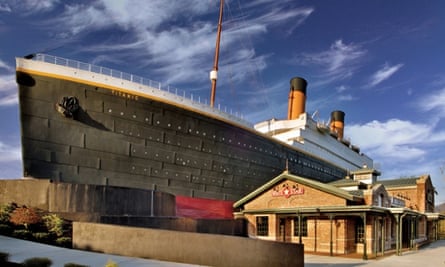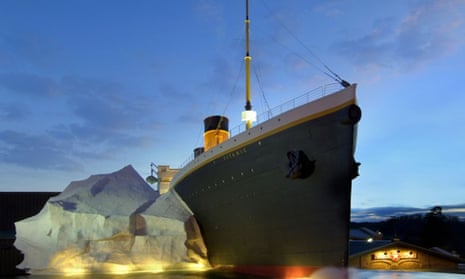The Titanic Museum Attraction in Pigeon Forge, Tennessee, wants me to die. Or at least, it wants me to imagine what it would be like.
I’m standing in the parking lot, looking up at a half-scale, 30,000-square-foot re-creation of the front half of the doomed ocean liner. A water fountain wraps around the Titanic’s bow, like a controlled sea. Above me, the lifeboats are still tethered to her side.
The attraction is the brainchild of John Joslyn, who in 1987, two years after the discovery of the Titanic, led a $6m expedition to recover a number of artifacts from the ocean floor. He and his team brought up many of the 400-plus objects that are now on display in Pigeon Forge, and at its sister museum in Branson, Missouri.
“John believed by offering a glimpse of life on board this massive vessel that in turn Titanic’s passengers and crew would never be forgotten,” explains the website.
Here, theater and reality merge into one. A white-haired man dressed as a captain greets me and hands me a boarding pass. He wears a pin that reads Crew Member. My boarding pass tells me that I’m Laura Francatelli, a 31-year-old first-class passenger and personal secretary to fashion designer Lucy, Lady Duff-Gordon, or “Lucile”. Laura’s ticket number – my ticket number – was PC 17485. I wonder what happened to her.

Experience museums believe in more than sympathy. They believe that we can experience what others have experienced, and feel what Susan Sontag calls “the pain of others”.
The United States Holocaust Memorial Museum in Washington DC gives visitors numbered identification cards chronicling the experiences of people living in Europe during the Holocaust. At the Apartheid Museum in Johannesburg, you receive a card that assigns you a racial identity, and you’re directed to one of two doors in order to “cut to the chase of what apartheid did, which was to divide and classify people”, according to museum director Christopher Till.
Until recently, visitors to the Imperial War Museum in London could partake in the “Trench Experience” in the first world war galleries and the “Blitz Experience” in the second world war galleries. Online reviews say that the smoke and the smell of sulfur are overwhelming. The trauma of history becomes personal.
It costs $27 to experience the sinking of the Titanic, which occurred between 11.40pm and 2.20am on 14-15 April 1912. I head inside, out of the sunshine and into a world of inevitable doom. (In Branson, you enter the museum through the iceberg itself, which rises up the side of the ship like a malignant growth.)
The woman who collects my ticket wears a long black dress, white apron and cap. I ask her if she is dressed as someone in particular. “I’m a first-class maid,” she says. “There were 23 of us aboard the Titanic, and 20 survived.”
In the first room, a docent outfitted as a captain is leading a tour. He stands in front of a large map that outlines the ship’s voyage in lighted dots. The Titanic’s progress is indicated by small model ships that resemble red jelly candies.
“The first few days were pretty calm,” he says, pausing dramatically. “But then they heard that famous word: ICEBERG!” The group laughs nervously. “I’d like you all to imagine what it would have been like to have been in those icy cold waters. It was pitch black. There was no moon that night. The water was only 28 degrees.” Everyone gasps.

Nearby is a display of the tools that Belfast craftsman Thomas McCauley of the Harland & Wolff shipyards used to work on the ship. A little boy gazes into the glass cabinet, his hands resting on either side. His eyes are wide.
The museum presents its artifacts as pseudo-religious relics capable of conjuring a lost world: aprons, dessert plates, blankets, tools, bedwarmers. These parts invoke an absent whole, and many are no more than fragments themselves: a piece of wood from the grand staircase, some decorative moulding, a swatch of green patterned carpet from the C-deck stateroom.
Visitors are constantly reminded of the rarity and value of these objects. I see a “very rare Titanic third-class menu” and a “rare” Memorial Booklet produced by the Institute of Marine Engineers. A deck chair with a hole in it is valued at more than $100,000. A child’s blouse is “priceless”. The green carpet swatch is worth $30,000. The price of every piece of china and silver is noted.
The objects’ authenticity is also underscored; they are leftovers from a now-mythic disaster, not props. A Harland & Wolff ledger book is a “One-of-a-kind Original”, with the word “original” underlined for emphasis. Also on display is an “original” telegram sent by a traveler to his family to alert them that he had survived. This fascination with authenticity extends to the re-created rooms, as well. Upon entering the third-class exhibit, I am informed: “You are looking at an authentic re-creation of a third-class cabin.”
This reminds me of Umberto Eco, who wrote that the United States is “a country obsessed with realism, where, if reconstruction is to be credible, it must be absolutely iconic, a perfect likeness, a ‘real’ copy of the reality being represented”.
Many visitors are impressed by how much the museum looks like James Cameron’s 1997 film, a supposed measure of the authentic. In an immaculate first-class parlor, I ask a captain-docent if he thinks people come here because they have seen the movie.
“Well, you know, in the film you’re meeting fictional characters, but here you are a real person aboard the ship.” I take this as a no.
The museum’s re-creations don’t limit themselves to interior spaces: there is also a mock-up of the ship’s bow on the night of the disaster. The room is freezing – the effect of massive amounts of air conditioning. A painted night scene like a Hollywood set surrounds me, and up ahead is an image of the iceberg, glimmering with silver and white glitter. Artificial stars twinkle above, and I lean against the ship’s railing and shiver. The sound of moaning, breaking ice reverberates through the room, as if the collision has already occurred, or is occurring perpetually.
I walk up to a narrow trough of water, and a sign tells me to plunge my hand into it. The water is 28 degrees: the temperature of the Atlantic that night.
In his 1915 poem The Convergence of the Twain, Thomas Hardy saw the Titanic and the iceberg as “twin halves of one august event”. My iceberg is just a picture, but this room is nonetheless creepy, and as I trail my hand in the trough of icy water, I feel certain that I could never know the experience of the Titanic.
I exit through the gift shop, which is stocked with Titanic snow globes, Titanics-in-a-bottle, Titanic trinket boxes and Titanic-embroidered handkerchiefs. A cheery saleswoman walks up to me.
“How was your voyage?” she asks.
I don’t know how to answer. I pick up one of the snow globes and turn it over in my hand.
“It was great,” I say.
“Who are you?” she asks.
I smile because I know what she means. “Laura Francatelli.”
“Oh, good,” she says. “You survived.”

Comments (…)
Sign in or create your Guardian account to join the discussion